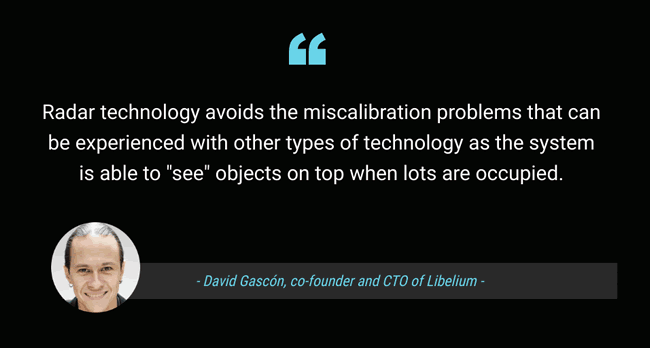The integration of radar technology in a smart parking node enables higher precision in Internet of Things applications to detect the occupation of parking spaces with the many benefits this offers for, among others, drivers, municipalities and the environment.
IoT pioneer Libelium has integrated radar technology in a new smart parking node. The device sends data to the cloud via non-cellular LPWA network standard LoRaWAN.
The radar technology is deployed in a project to detect the occupation of parking spaces for disabled people in the city of Huesca in Spain (where Libelium was founded) with 190 new smart parking nodes in place.
Detecting the occupation of parking spaces is the main use case for the inclusion of a radar sensor in the new smart parking node. By adding the possibility to detect the availability of parking spaces through radar technology the company wants to meet growing demand for greater precision in smart parking devices.

Benefits of smart parking for drivers, municipalities and the environment
IoT technology applied to the detection of parking places can reduce traffic, save fuel, decrease CO2 emissions and improve the driving experience and habitability of cities according to the company.
Smart parking devices are also on the radar (pun not intended) of many municipalities so they can check rotation levels in restricted parking areas (taxis, loading and unloading, recharging electric vehicles and disabled areas).
Smart parking (and smart cities) has been a key focus area of Libelium since many years (along with, among others, environmental applications and smart farming). Its smart parking platform was launched in 2011. The platform’s dual detection system, dual wireless communication, dual installation deployment, software and hardware characteristics made it one of the most interoperable and scalable smart parking systems of the IoT market as Libelium reminds at the occasion of the launch of a series of smart city reports. The first one is a Smart Parking IoT Solution Quick Report.
Back to the new smart parking node with radar technology. Libelium states that the new smart parking node improves detection and stability performance thanks to the radar sensor which allows precise detection (99%) of vehicles parked.

Benefits of radar technology for smart parking deployments
Radar technology offers improved performance compared to magnetic or infrared detection. Moreover, radar parking devices are not vulnerable to electromagnetic interference nor do they give false positives for vehicles parked near or in double rows, Libelium adds.
Their performance is more consistent in any luminosity condition, more stable in long stay parking cases and they are not affected by the proximity of traffic movements such as passing bus or heavy trucks. Additionally, the maintenance of radar parking sensors is much easier as they are not affected by dirt, dust, rain or oil spills.
David Gascón, co-founder and CTO of Libelium adds: “Radar technology avoids the miscalibration problems that can be experienced with other types of technology as the system is able to ‘see’ objects on top when lots are occupied”.
More on the Libelium smart parking node with radar technology
Libelium says that nodes provisioning has been enormously improved, now delivered with default time settings and unique LoRaWAN identifiers and keys, allowing the registration in the LoRaWAN network server at any one time.
The new smart parking platform also provides over-the-air setup to remotely configure parameters, reducing installation times.
Smart parking devices are registered in the Libelium Services Cloud Manager before leaving the factory. They can also be used in combination with the Libelium Cloud Bridge to send data directly to any of the compatible platforms, making it easier and faster to create any parking management application.
The new smart parking devices (CE, FCC and IP68 certified) are available for the EU, US, Latam, India, Asia Pacific and Australia.
All pictures courtesy Libelium.







